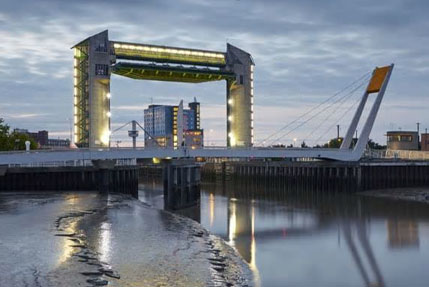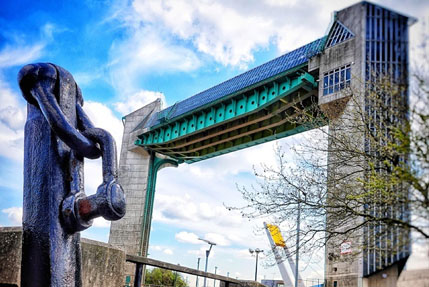Myth Buster #4: Six lessons about flooding and flood resilience

Photo taken by the author
The risk of flooding is increasing as the climate warms. In the June edition of the GJA newsletter (#61) we highlighted the campaign in Lowestoft for adequate flood protection. Here Dr Jessica Fox, Senior Flood Risk Officer for Hull City Council, provides a wealth of valuable information about flooding, it’s causes, minimising the risk and, importantly, laying to rest persistent myths about where, when and why flooding may occur.
1. I’ve never flooded before so I’m safe – false.
a. How long have you lived in your house? Did you check if the property had been flooded before you moved in? Even if there is no history of flooding it absolutely does not mean flooding will never happen there in the future. Our local environments are responding to a rapidly changing global climate. This means we’re going to see things happen that haven’t happened before, like more flooding.
b. In the same way people will think, I haven’t flooded since 2007 so I won’t flood again in my lifetime because that was a 1 in 100 year flood event. People have a short-term memory when it comes to remembering traumatic events, such as flooding. And also denial that it simply can’t happen again. This is unfortunately not true.
2. I don’t live near a river or the sea so I’m safe – false.
It’s a natural assumption that only people who live near to rivers or on the coast are at risk of flooding, after all Geography in school teaches us about the hazards of rivers flooding, coastal erosion, and sea level rise. However, these aren’t the only sources of flood risk, there are many others! Have you ever noticed drains overflowing (sewer flooding) or how many times have you seen ‘puddles’ in the same place every time it rains (surface water flooding)? In the natural environment, water infiltrates into the ground but that can’t happen where there are lots of hard surfaces like concrete. So water pools on the surface until it can find a way down or out, which means the risk of it pooling in areas we live is high. And then there’s the silent source, the one we can’t see – groundwater flooding – which tends to happen after a heavy or prolonged rainfall event. It catches people by surprise because we can’t see what’s happening underground in the same way we can watch river levels rise so it’s much harder to understand and predict.
3. Dredging rivers will solve the flooding problem – false.
a. Historically, dredging was regularly carried out when rivers were heavily used for the maritime industry. This is no longer the case since the decline in the number of ships using rivers for transportation. Dredging is sometimes used to reduce flood risk. The idea behind dredging is to allow water to flow as quickly as possible from one point to another and in some cases, this is an effective method. However, it is not always effective or sustainable and it can increase flood risk downstream.
b. Dredging isn’t always the best option, this is because:
i. In many places across England, the land is so flat there is little natural flow – so dredging would not speed up the movement of water.
ii. It would not be sustainable to dredge as sediment is added to the system quickly.
iii. It would be bad for plants and wildlife who live along the river. Dredging disturbs their habitats and feeding spots and also stirs up sediment, which could be contaminated from historical industrial activity.
iv. It’s also very expensive to dispose of contaminated sediment if it is removed.
For more information, access Floods and Dredging – A Reality Check.
c. Quite importantly, dredging rivers does not reduce the risk or prepare us for the ever-increasing surface water and sewer flood risk. Dredging is an outdated method and is being replaced by schemes designed to hold back water and store it until drainage systems have capacity to take it.
4. It’s not my responsibility to deal with flooding – false.
a. Whose job is it? Whose job should it be? – Two very valid questions for our new Government. It’s everyone’s responsibility to play their part in managing flood risk. Flooding is a shared responsibility. Authorities such as the Environment Agency deal with flooding from rivers and the sea but, to add an element of confusion, the EA only deal with ‘Main Rivers’ (Designation of ‘main rivers’ – GOV.UK) not ‘Ordinary Watercourses’ – those are up to the Local Authority. Local Authorities also deal with surface water and groundwater flooding, Water Companies manage sewer flooding, and there are others like Internal Drainage Boards who have a role to play. The different designation of roles and responsibilities, as set out in legislation, makes it difficult to report flooding when it happens, which adds undue stress. But none of these organisations have a responsibility to prevent flooding from happening, that’s important to realise.
b. There isn’t a specific piece of legislation that defines the role of ‘everyone else’. Rather the Environment Agency announced in their most recent National Flood and Coastal Erosion Risk Management Strategy seeks to build a nation of people who:
I. Understand their risk to flooding and coastal change.
ii. Know their responsibilities and how to take action.
c. So there we have it, if you want to be proactive in preparing for the inevitable increase in flood risk that we all face, then YOU must take action. The organisations mentioned above will not be able to take all the action for you. Despite the challenges around predicting and warning of different types of flooding, there’s plenty of measures you/ we can take to be proactive in preparing for potential flooding. See this link, for example:
BeFloodReady – Property Flood Resilience (PFR) | Helping Reduce Flood Risk
5. Global warming is making Earth hotter so that means there’ll be less rain and less chance of flooding – false.
a. Naturally, when we think of warmer weather we automatically think of dry and sunny conditions. However, when we talk about a warmer globalclimate, this redefines what a warmer local climate will look like – it actually already is, remember the rain and flooding in 2007, 2014, 2016, 2020 and the winter we’ve just experienced (see Met Office seasonal-assessment for Winter 24). Year on year we read in the media that we’ve experienced the wettest year on record. This is going to keep happening.
b. When the temperature in the atmosphere gets warmer, more water is evaporated into the air, which increases moisture in the air, which means more water in clouds and more clouds so more rain. Even on a beautiful day with warm temperatures and blue skies, the weather can change very quickly with clouds bursting with intense rainfall, increasing the likelihood of flooding. Ergo, more frequent and more intense rainfall events.
c. At the same time, because of the warmer temperatures, more evaporation and less water on the ground, we can expect more droughts as well. Again, we’re already experiencing this, how many heatwaves have we had in the last few years?!
d. Essentially, summers with not enough water and winters with too much – how do we balance this? Capture the summer rainfall as it falls and use it during the drier months, capture and store the excess winter rainfall, reuse where possible and wait for the water to drain away naturally.
6. There are no natural disasters, only natural hazards – true.
a. We read about disasters in the news, but sometimes disasters are reported as ‘natural disasters’. There’s no such thing as a natural disaster – only natural hazards (see UNDRR No Natural Disasters). Here, we’re talking about flooding being the natural hazard and flooding events being disasters. We, humans, turn natural hazards into disasters because we add the element of hazard, exposure and vulnerability, which results in disaster – especially if we’re not prepared.
b. Disaster = hazard + exposure + vulnerability
c. It’s up to every single one of us to stop a hazard from becoming a disaster. How can we do this?
i. Check your flood risk.
ii. Understand what sources of flooding you’re at risk from where you live and work.
iii. Prepare for flooding.
iv. Install property flood resilience and resistance measures to your property if you’re at risk.
v. Teach your family about flood risk and prepare a flood plan together, this could involve understanding when to evacuate or when to stay put and move to a higher place of safety.
vi. Register for flood warnings here: sign up for Met Office weather warnings.
vii. Check what type of flood warnings are currently available for your area. There aren’t flood warnings for all sources of flooding, for example surface water flooding because it’s very hard to predict and happens so quickly, that’s why it’s so important to complete steps i and ii.
viii. Taking action now, will save you time, money and stress if you are impacted by flooding – so what are you waiting for?
Note from the author
This article is not written to scare people. As humans, we have settled (and resettled) next to water for thousands of years, because we need it! I am trying to get across that this is a problem we all face and need to accept and prepare for together. There are too many brilliant schemes already out there to name them all, but not enough, we need more, and with this will hopefully come a change in the perception of how we view water and flooding. There are inevitably going to be water-related shocks and stresses in the coming years, but we can limit the impact of these by taking preparatory action now. Once we start doing this, we can live with a much better relationship to our environment and reap its benefits.
Photo courtesy of Hull City Council
Photo courtesy of Hull City Council


